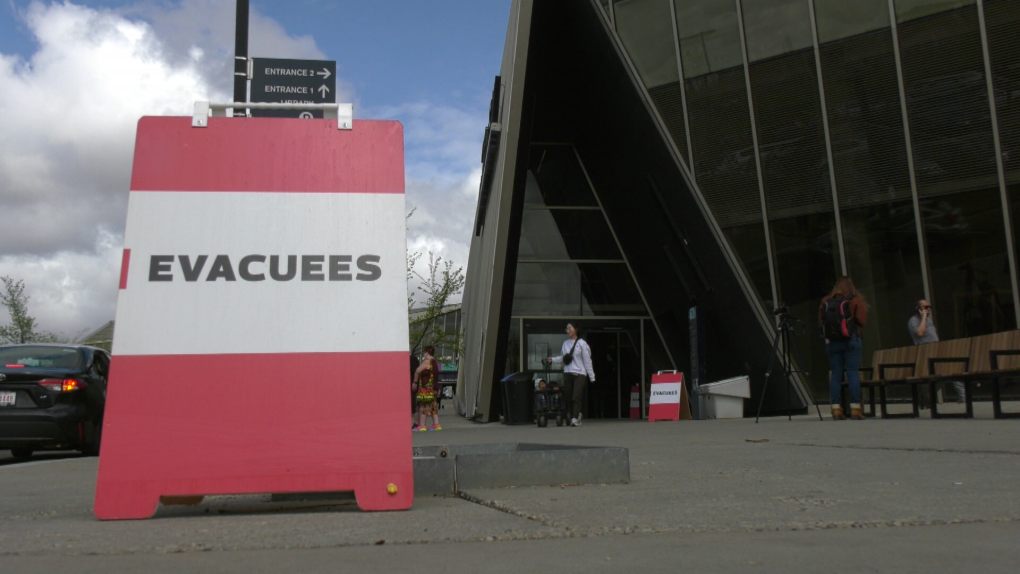Tuesday’s drive out of Fort McMurray under orange, smoke-filled skies was a harrowing reminder for evacuees who also fled the threat of wildfire in 2016.
“Everything came rushing back,” Ken Plamondon, who lives in one of the four neighbourhoods that was evacuated Tuesday afternoon, told CTV News Edmonton the next morning.
He had spent the night in his truck with his dog in Lac La Biche, the pair having arrived in the hamlet nearly 300 kilometres south of Fort McMurray to find no hotel rooms left.
Plamondon said they were among the last to hit the road because he was two hours outside of Fort McMurray when the two-hour evacuation order was issued.
By the time he reached his home city, his house was covered in embers and the neighbourhood looked like a “ghost town.”
“The fire looked like it was getting real close real fast; the wind was changing direction quite a bit and it just – you knew it was inevitable,” he recalled.
The scene was eerily similar to eight years ago, right before a wildfire breached Fort McMurray’s limits.
“There was so many traumatic things … (during) the last fire that happened,” Plamondon said. “(I’m) pretty rattled over it.”
This was the sentiment, too, of Mike Major, who arrived in Edmonton with his two children around 3 a.m.
“We took every picture off the wall this time,” he said.
“It was just orange. It reminded me (of 2016), other than the trees beside the highway being on fire. You could see the fire in the distance. Everything was the exact same except for things flowed a little more smoothly this time.”
Evacuation took hours: residents
As of Wednesday morning, the 21,000-hectare wildfire that prompted the evacuation order – officially named MWF-017 – was 5.5 kilometres away from the Rural Municipality of Wood Buffalo’s landfill southwest of Fort McMurray.
When the evacuation order was issued Tuesday, it had been about 7.5 kilometres away from the landfill but moving toward Fort McMurray.
Diane Tremblay learned of the evacuation order while having coffee with friends. While her neighbourhood was evacuated, she left anyway, unable to manage her anxiety since 2016.
Because of post-traumatic stress disorder, says she keeps her vehicle packed so she can leave at a moment’s notice.
“Anything to do with the fire, I get upset, because I don’t know if I’m going to survive it or not. I lost everything in 2016 and I had to start over.”
All of the residents reported a smoother process leaving Fort McMurray on Tuesday than in 2016, even if it still was slow going.
“Just trying to get out of Abasand (one of the neighbourhoods evacuated) up the hill to Gregoire took almost two hours when normally it would be a five-minute drive – not even,” recalled Abasand resident Marina Barnes, who was able to get a hotel room in Lac La Biche.
“It was very packed and we had emergency crews going down the wrong side of the highway, up the shoulder. It was a little bit chaotic.”
Another Abasand resident who stayed in Lac La Biche for rest on the way to Saskatchewan, Justin Payne, said he and his family woke up early in anticipation of being told to leave.
“There was just good steady smoke in the air and the smell of burning, you could smell it and you could see the orange glow in the sky. And we knew it was coming, so we started packing up then.”
So did Susan Walker, who didn’t want to stay late enough to have to drive through flames like she did eight years ago.
“That was my big concern because it looked a lot like it did in 2016 just before the flames hit the town,” she said of the scene Tuesday.
Evacuation centres are open in Lac La Biche, Cold Lake and Edmonton. The latter are both about 430 kilometres south of Fort McMurray. The centres are providing basic necessities, pet care, and accommodation support.
 A centre for evacuees was set up at the Clareview Community Recreation Centre in Edmonton on May 14, 2024. (CTV News Edmonton)
A centre for evacuees was set up at the Clareview Community Recreation Centre in Edmonton on May 14, 2024. (CTV News Edmonton)
“Unfortunately, we are getting very good at setting up these evacuation (centres),” Edmonton mayor Amarjeet Sohi said, welcoming evacuees.
“I think this time around people have had the benefit of the two-hour notice and they came a little bit more prepared. And I think over the course of the last couple of years, everybody’s preparedness level has increased because of the wildfires,” commented an Edmonton emergency support response team coordinator, Gerry Clarke. “So we’re seeing still a lot of people, but their requirements and needs aren’t quite like they were the last couple of years.”
“The hospitality is great,” Fort McMurray born-and-raised resident Cody Batten said. “You gotta appreciate that. It goes a long way – especially in a situation where you’re coming with nothing, you don’t know where you’re going. It means a lot.”
Edmonton’s evacuation reception centre is located at the Clareview Community Recreation Centre at 3804 139 Ave. Cold Lake’s evacuation reception centre is located at the Agriplex at 4608 38 Ave.
In Edmonton, evacuees can access services at the YMCA free of charge with picture ID.
Evacuees who register at a centre have been directed to not attempt to switch locations.
The province will compensate evacuees $1,250 per adult and $500 per child who are displaced for more than seven days.
Anyone who leaves before an evacuation is ordered will not be reimbursed.
With files from CTV News Edmonton’s Nicole Lampa, Evan Klippenstein and Nav Sangha